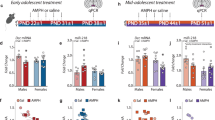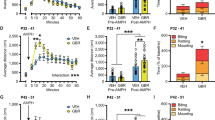Abstract
Netrins are guidance cues that play a fundamental role in organizing the developing brain. The netrin receptor, DCC (deleted in colorectal cancer), is highly expressed by dopaminergic (DA) neurons. DCC may therefore participate in the organization of DA circuitry during development and also influence DA function in the adult. Here we show that adult dcc heterozygous mice exhibit a blunted behavioral response to the indirect DA agonist amphetamine and do not develop sensitization to its effects when treated repeatedly. These behavioral alterations are associated with profound changes in DA function. In the medial prefrontal cortex, dcc heterozygotes exhibit increased tyrosine hydroxylase (TH) protein levels and dramatic increases in basal concentrations of DA and DA metabolites. In contrast, in the nucleus accumbens, dcc heterozygotes show no changes in either TH or DA levels, but exhibit decreased concentrations of DA metabolites, suggesting reduced DA activity. In addition, dcc heterozygous mice exhibit a small, but significant reduction in total number of TH-positive neurons in midbrain DA cell body regions. These results demonstrate for the first time that alterations in dcc expression lead to selective changes in DA function and, in turn, to differences in DA-related behaviors in adulthood. These findings raise the possibility that changes in dcc function early in life are implicated in the development of DA dysregulation observed in certain psychiatric disorders, such as schizophrenia, or following chronic use of drugs of abuse.
This is a preview of subscription content, access via your institution
Access options
Subscribe to this journal
Receive 12 print issues and online access
$259.00 per year
only $21.58 per issue
Buy this article
- Purchase on Springer Link
- Instant access to full article PDF
Prices may be subject to local taxes which are calculated during checkout




Similar content being viewed by others
References
Kalivas PW, Stewart J . Dopamine transmission in the initiation and expression of drug- and stress-induced sensitization of motor activity. Brain Res Brain Res Rev 1991; 16: 223–244.
Robinson TE, Berridge KC . The psychology and neurobiology of addiction: an incentive-sensitization view. Addiction 2000; 95: S91–S117.
de Wit H . Individual differences in acute effects of drugs in humans: their relevance to risk for abuse. NIDA Res Monogr 1998; 169: 176–187.
Piazza PV, Deroche V, Rouge-Pont F, Le Moal M . Behavioral and biological factors associated with individual vulnerability to psychostimulant abuse. NIDA Res Monogr 1998; 169: 105–133.
Lipska BK, Weinberger DR . To model a psychiatric disorder in animals: schizophrenia as a reality test. Neuropsychopharmacology 2000; 23: 223–239.
Lieberman JA, Sheitman BB, Kinon BJ . Neurochemical sensitization in the pathophysiology of schizophrenia: deficits and dysfunction in neuronal regulation and plasticity. Neuropsychopharmacology 1997; 17: 205–229.
Yui K, Goto K, Ikemoto S, Ishiguro T, Angrist B, Duncan GE et al. Neurobiological basis of relapse prediction in stimulant-induced psychosis and schizophrenia: the role of sensitization. Mol Psychiatry 1999; 4: 512–523.
Laruelle M . The role of endogenous sensitization in the pathophysiology of schizophrenia: implications from recent brain imaging studies. Brain Res Brain Res Rev 2000; 31: 371–384.
Ventura R, Alcaro A, Cabib S, Conversi D, Mandolesi L, Puglisi-Allegra S . Dopamine in the medial prefrontal cortex controls genotype-dependent effects of amphetamine on mesoaccumbens dopamine release and locomotion. Neuropsychopharmacology 2004; 29: 72–80.
Lewis DA, Levitt P . Schizophrenia as a disorder of neurodevelopment. Annu Rev Neurosci 2002; 25: 409–432.
Boksa P . Animal models of obstetric complications in relation to schizophrenia. Brain Res Rev 2004; 45: 1–17.
Marcotte ER, Pearson D, Srivastava LK . Animal models of schizophrenia: a critical review. J Psychiatry Neurosci 2001; 26: 395–410.
Dickson B . Molecular mechanisms of axon guidance. Science 2002; 298: 1959–1964.
Manitt C, Kennedy TE . Where the rubber meets the road: netrin expression and function in developing and adult nervous systems. Prog Brain Res 2002; 137: 425–442.
Livesey FJ, Hunt SP . Netrin and netrin receptor expression in the embryonic mammalian nervous system suggests roles in retinal, striatal, nigral, and cerebellar development. Mol Cell Neurosci 1997; 8: 417–429.
Volenec A, Zetterstrom TS, Flanigan TP . 6-OHDA denervation substantially decreases DCC mRNA levels in rat substantia nigra compacta. Neuroreport 1998; 9: 3553–3556.
Fazeli A, Dickinson SL, Hermiston ML, Tighe RV, Steen RG, Small CG et al. Phenotype of mice lacking functional Deleted in colorectal cancer (Dcc) gene. Nature 1997; 386: 796–804.
Flores C, Samaha AN, Stewart J . Requirement of endogenous basic fibroblast growth factor for sensitization to amphetamine. J Neurosci 2000; 20: RC55.
West MJ, Gundersen HJ . Unbiased stereological estimation of the number of neurons in the human hippocampus. J Comp Neurol 1990; 296: 1–22.
van den Munckhof P, Luk KC, Ste-Marie L, Montgomery J, Blanchet PJ, Sadikot AF et al. Pitx3 is required for motor activity and for survival of a subset of midbrain dopaminergic neurons. Development 2003; 130: 2535–2542.
Moroz IA, Rajabi H, Rodaros D, Stewart J . Effects of sex and hormonal status on astrocytic basic fibroblast grwoth factor-2 and tyrosine hydroxylase immunoreactivity after medial forebrain bundle 6-hydroxydopamine lesions of the midbrain dopamine neurons. Neuroscience 2003; 118: 463–476.
Vezina P . Amphetamine injected into the ventral tegmental area sensitizes the nucleus accumbens dopaminergic response to systemic amphetamine: an in vivo microdialysis study in the rat. Brain Res 1993; 605: 332–337.
Cador M, Bjijou Y, Stinus L . Evidence of a complete independence of the neurobiological substrates for the induction and expression of behavioral sensitization to amphetamine. Neuroscience 1995; 65: 385–395.
Vezina P . D1 dopamine receptor activation is necessary for the induction of sensitization by amphetamine in the ventral tegmental area. J Neurosci 1996; 16: 2411–2420.
Le Moal M, Simon H . Mesocorticolimbic dopaminergic network: functional and regulatory roles. Physiol Rev 1991; 71: 155–234.
Knable MB, Weinberger DR . Dopamine, the prefrontal cortex and schizophrenia. J Psychopharmacol 1997; 11: 123–131.
Tam SY, Roth RH . Mesoprefrontal dopaminergic neurons: can tyrosine availability influence their functions? Biochem Pharmacol 1997; 53: 441–453.
Carr DB, Sesack SR . Projections from the rat prefrontal cortex to the ventral tegmental area: target specificity in the synaptic associations with mesoaccumbens and mesocortical neurons. J Neurosci 2000; 15: 3864–3873.
Tzschentke TM . Pharmacology and behavioral pharmacology of the mesocortical dopamine system. Prog Neurobiol 2001; 63: 241–320.
Steketee JD . Neurotransmitter systems of the medial prefrontal cortex: potential role in sensitization to psychostimulants. Brain Res Rev 2003; 41: 203–228.
Benes FM, Taylor JB, Cunningham MC . Convergence and plasticity of monoaminergic systems in the medial prefrontal cortex during the postnatal period: implications for the development of psychopathology. Cereb Cortex 2000; 10: 1014–1027.
Louilot A, Le Moal M, Simon H . Opposite influences of dopaminergic pathways to the prefrontal cortex or the septum on the dopaminergic transmission in the nucleus accumbens. An in vivo voltammetric study. Neuroscience 1989; 29: 45–56.
Mitchell JB, Gratton A . Partial dopamine depletion of the prefrontal cortex leads to enhanced mesolimbic dopamine release elicited by repeated exposure to naturally reinforcing stimuli. J Neurosci 1992; 12: 3609–3618.
Stewart J, Deschamps SE, Amir S . Inhibition of nitric oxide synthase does not block the development of sensitization to the behavioral activating effects of amphetamine. Brain Res 1994; 641: 141–144.
Sorg BA, Kalivas PW . Effects of cocaine and footshock stress on extracellular dopamine levels in the medial prefrontal cortex. Neuroscience 1993; 53: 695–703.
Sorg BA, Davidson DL, Kalivas PW, Prasad BM . Repeated daily cocaine alters subsequent cocaine-induced increase of extracellular dopamine in the medial prefrontal cortex. J Pharmacol Exp Ther 1997; 281: 54–61.
Prasad BM, Hochstatter T, Sorg BA . Expression of cocaine sensitization: regulation by the medial prefrontal cortex. Neuroscience 1999; 88: 765–774.
Sorg BA, Li NA, Wu WR . Dopamine D1 receptor activation in the medial prefrontal cortex prevents the expression of cocaine sensitization. J Pharmacol Exp Therap 2001; 297: 501–508.
Lieberman JA, Kane JM, Alvir J . Provocative tests with psychostimulant drugs in schizophrenia. Psychopharmacology 1987; 91: 415–433.
Solanto MV . Dopamine dysfunction in AD/HD: integrating clinical and basic science research. Behav Brain Res 2002; 130: 65–71.
Akil M, Pierri JN, Whitehead RE, Edgar CL, Mohila C, Sampson AR et al. Lamina-specific alterations in the dopamine innervation of the prefrontal cortex in schizophrenic subjects. Am J Psychiatry 1999; 156: 1580–1589.
Acknowledgements
This work was supported by the Canadian Institutes of Health Research (AFS, CF, JS, TEK), the Parkinson's Society of Canada (AFS), and the Natural Science and Engineering Research Council of Canada (CF).
Author information
Authors and Affiliations
Corresponding authors
Rights and permissions
About this article
Cite this article
Flores, C., Manitt, C., Rodaros, D. et al. Netrin receptor deficient mice exhibit functional reorganization of dopaminergic systems and do not sensitize to amphetamine. Mol Psychiatry 10, 606–612 (2005). https://doi.org/10.1038/sj.mp.4001607
Received:
Revised:
Accepted:
Published:
Issue Date:
DOI: https://doi.org/10.1038/sj.mp.4001607
Keywords
This article is cited by
-
Reduced dopamine release in Dcc haploinsufficiency male mice abolishes the rewarding effects of cocaine but not those of morphine and ethanol
Psychopharmacology (2023)
-
The Netrin-1/DCC guidance system: dopamine pathway maturation and psychiatric disorders emerging in adolescence
Molecular Psychiatry (2020)
-
Further confirmation of netrin 1 receptor (DCC) as a depression risk gene via integrations of multi-omics data
Translational Psychiatry (2020)
-
An Association Study Between Genetic Polymorphisms in Functional Regions of Five Genes and the Risk of Schizophrenia
Journal of Molecular Neuroscience (2016)
-
Resilience to amphetamine in mouse models of netrin-1 haploinsufficiency: role of mesocortical dopamine
Psychopharmacology (2015)



